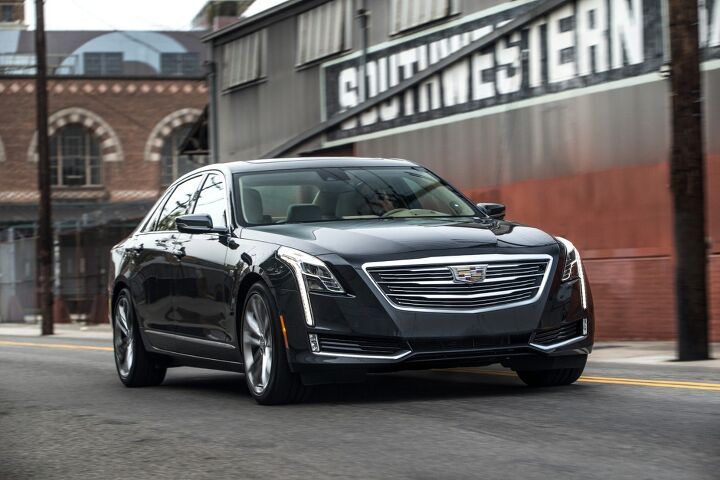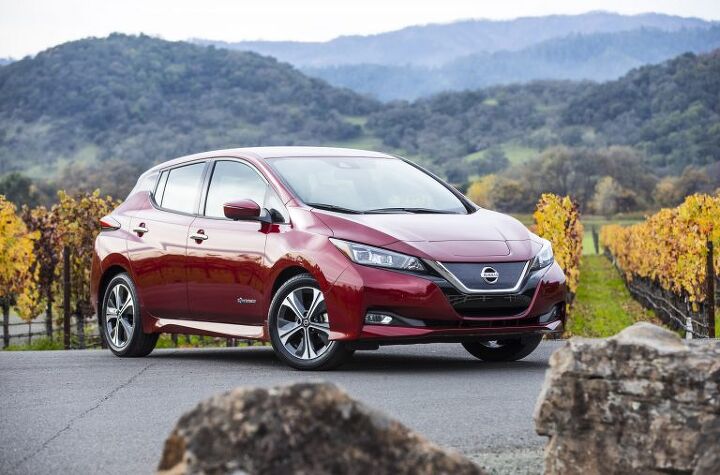Hands Off: Cadillac's Super Cruise Beats Tesla's Autopilot in First Consumer Reports Ranking

Now that new car buyers have a decent selection of semi-autonomous driving systems to choose from, Consumer Reports felt it would be a good idea to put them to the test.
Expect to see much consternation expressed on Tesla forums. The rankings, which pitted Cadillac’s Super Cruise against Tesla’s groundbreaking Autopilot, Nissan’s ProPilot Assist, and Volvo’s Pilot Assist, shows GM’s luxury marque in the lead.
What propelled Cadillac’s system to the top of the heap? The same element that gave Tesla’s system a black eye two years ago: safety.
The GM-developed system won the comparison test hands-down, and did so because it gives the driver a short leash — preventing its operation under unsafe conditions. Super Cruise literally watches the driver, and won’t let up with the nagging. We’ve lauded its usefulness in preventing incidents like this.
Tesla’s system ranked second, with the Nissan and Volvo systems coming at third and fourth, respectively. Consumer Reports said semi-autonomous systems have been on its radar for a couple of years now, but now that they’ve entered the mainstream, the publication felt it was the right time to alert buyers to the pros and cons of individual systems.
“Stacked up against each other, you can really see significant differences,” said Jake Fisher, director of auto testing. “The best systems balance capability with safeguards—making driving easier and less stressful in the right situations. Without proper safeguards, over-reliance on the system is too easy, which puts drivers at risk.”
CR also doesn’t like some of the messaging being sent to would-be buyers. It slapped Volvo for listing Pilot Assist as an “autonomous” system on its website, a falsehood the automaker quickly removed.
With Super Cruise and Autopilot, CR liked how the systems kept the vehicle centered in its lane on varying types of roadways, while the Nissan and Volvo systems couldn’t corral wandering on twisty stretches. Autopilot was judged the easiest to use, and the system makes it clear whether it’s turned on or off.
GM only lets drivers use Super Cruise when on a divided highway mapped by the automaker, while the other systems offer more freedom of use. This in itself can be a safety issue. Super Cruise also provides early warning for looming roadway changes.
“Super Cruise is the only system that provides ample warning to the driver as it approaches merging lanes, off-ramps, and difficult traffic patterns,” CR wrote. “All the other systems lack early warnings and can be used in places they’re not designed to be used. On some secondary roads, Tesla’s Autopilot limits how fast the car can go but still allows the system to be used. It even allows use on small, curvy roads with poor lane markings—and operates erratically in these situations rather than locking the system out. While bad weather can disable all the systems, Nissan’s ProPilot Assist and Volvo’s Pilot Assist lock drivers out in moderate rain.”
In terms of driver monitoring, Super Cruise — the only system to use eye-tracking technology — won handily. As each of these systems demand that the driver stay alert and be ready to take the wheel at any time, preventing cabin shenanigans is key.
“We saw significant differences among the systems in how long they waited to warn the driver to respond, ranging from 4 seconds for the Super Cruise to 24 seconds for Autopilot,” CR wrote, noting that the other three systems base their warnings on the time elapsed since the driver last placed a hand on the wheel. Cadillac’s system utilizes a seat-shaker mechanism to jolt drowsy or inattentive drivers. It also locks out the system if it feels you’re misusing it.
“This is an insufficient way of measuring driver attention,” CR said of the non-Super Cruise systems, “and it provides little assurance that the driver is even awake. Because of the impressive ability of Tesla’s Autopilot to keep the vehicle centered in its lane, it’s easy for drivers to become over-reliant on it. Pilot Assist from Volvo and Nissan’s ProPilot Assist are far less capable, and that forces drivers to stay involved with steering, or risk leaving the lane on all but the straightest roads.”
Each system behaves differently in the event the driver doesn’t respond. While the Cadillac system, after a series of audible and visual warnings similar to Tesla’s system, turns off until the next time the vehicle is restarted (a features also shared with Tesla), it will also brake to a stop in its lane, flashers on. It then calls an emergency number. A Tesla will not. Nissan’s system initiates “sudden, hard braking” after the driver fails to respond to a series of prompts. If Volvo drivers fail to respond to warnings, “the system shuts off completely and does not apply braking or any lane assist. Only if the driver has previously enabled the lane-keeping system, which is separate from the Pilot Assist system, will the vehicle detect lane departure and provide some steering.”
The takeaway from these tests is pretty obvious. Safe operation of this kind of system demands the vehicle pay close attention to what the driver is doing, and most automakers need to step up their game in this area. At a bare minimum.
[Images: General Motors, Tesla, Nissan, Volvo Cars]

More by Steph Willems
Latest Car Reviews
Read moreLatest Product Reviews
Read moreRecent Comments
- Urlik You missed the point. The Feds haven’t changed child labor laws so it is still illegal under Federal law. No state has changed their law so that it goes against a Federal child labor hazardous order like working in a slaughter house either.
- Plaincraig 1975 Mercury Cougar with the 460 four barrel. My dad bought it new and removed all the pollution control stuff and did a lot of upgrades to the engine (450hp). I got to use it from 1986 to 1991 when I got my Eclipse GSX. The payments and insurance for a 3000GT were going to be too much. No tickets no accidents so far in my many years and miles.My sister learned on a 76 LTD with the 350 two barrel then a Ford Escort but she has tickets (speeding but she has contacts so they get dismissed or fine and no points) and accidents (none her fault)
- Namesakeone If I were the parent of a teenage daughter, I would want her in an H1 Hummer. It would be big enough to protect her in a crash, too big for her to afford the fuel (and thus keep her home), big enough to intimidate her in a parallel-parking situation (and thus keep her home), and the transmission tunnel would prevent backseat sex.If I were the parent of a teenage son, I would want him to have, for his first wheeled transportation...a ride-on lawnmower. For obvious reasons.
- ToolGuy If I were a teen under the tutelage of one of the B&B, I think it would make perfect sense to jump straight into one of those "forever cars"... see then I could drive it forever and not have to worry about ever replacing it. This plan seems flawless, doesn't it?
- Rover Sig A short cab pickup truck, F150 or C/K-1500 or Ram, preferably a 6 cyl. These have no room for more than one or two passengers (USAA stats show biggest factor in teenage accidents is a vehicle full of kids) and no back seat (common sense tells you what back seats are used for). In a full-size pickup truck, the inevitable teenage accident is more survivable. Second choice would be an old full-size car, but these have all but disappeared from the used car lots. The "cute small car" is a death trap.





































Comments
Join the conversation
"It slapped Volvo for listing Pilot Assist as an “autonomous” system on its website, a falsehood the automaker quickly removed." It's not a falsehood. Any system that intervenes has met the minimum requirements for autonomy.
The only autonomous driving tech I really lust after is how my Dad's new F150 will back his trailer up for him. Sure, I am competent enough to do it myself, but I think it is really cool and I do it frequently enough that it would be nice.